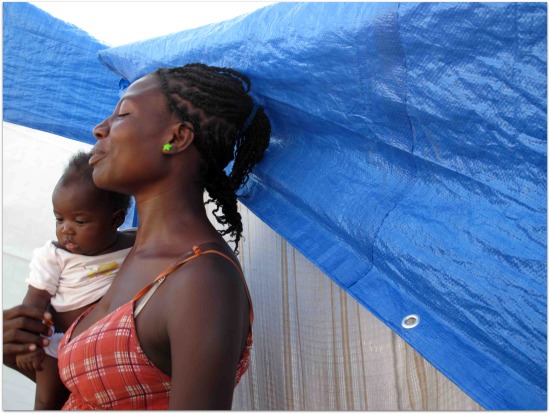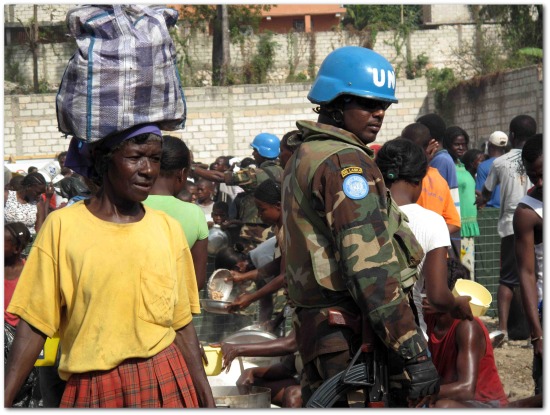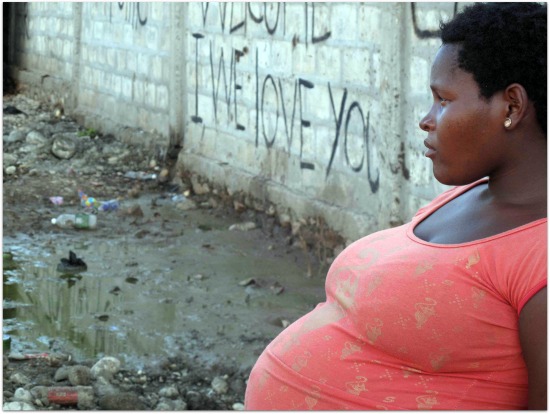Goudou Goudou (1)
By:
November 15, 2010
First in a series of posts.

There is something odd about the soccer game. The kicks hit true but the sound is a fwap, air burped out of a tire, the trajectory oblique. A dozen or so boys scramble after the errant ball. There are no boundaries, no goals, and the game careens out of control, up and over mounds of garbage, three boys and the ball slamming into a UN truck filled with Venezuelan soldiers, who laugh and cheer.
Their walled soccer field, now christened Camp Pinchinat, has become an ever-expanding sprawl of tents. A few days after the goudou goudou, as the Haitians call it, the tremblement de terre, or, as the mountain people whisper, “the attack,” the newly homeless wandered in, pitched sticks and sheets, and crawled under. The first pelting rainstorm blew them down as easily as the huff and puff of the big bad wolf. Now there are real tents, albeit stultifying hot military tents, divided with sheets to house eight families in each. A few Sri-Lankans in military camo lean on the high cement wall watching helplessly. They can’t speak Haitian Creole, are not authorized to use the guns they carry, and appear baffled, as if they’ve wandered into the wrong movie.
Nesley, his squat, fireplug body planted on the earth as if he’s got roots, tells me Haitians were ignoring certain gods, so the earth bellowed. Nesley is a hougan, a Vodou priest; he lost his temple and his house. His wife emerges from under their blue tarp home and tells the story of saving her baby, her pride swelling so large it lifts us all out of the mud for a brief moment. She has a regal, high-boned face and also stands as if confident her roots grip the planet.
A woman from the mountains tells me, “The Americans made the earthquake.” As proof she tells a tale of atomic testing done out in the sea when she was a child.

My Haitian film students are devoted to telling the stories of their country in their own circuitous, gentle style. They film as they live: wander into a life, look around, notice things, leave. No prying, no trickery, no push to find an ending.
Today we’re filming Sonise, a 17-year-old pregnant girl with an easy smile that somehow only increases her impenetrability. She’s about to have her first baby in mud, filth and stench. I ask Keziah, one of my students, what she thinks of Sonise. Keziah’s a statuesque Haitian with a body steady as a tripod, making her a perfect hand-held shooter. Keziah says: “Sonise? She should be very afraid. But she’s not.”
Sonise wears a brilliant yellow shirt. Her belly swell glows like a sun and precedes her swagger by a foot. Her gait is rolling and sexy, her head held high and steady, her face placid. She’s on a long walk to a long wait to get a short share of daily rice. She lost her man in the earthquake. “I wear red underwear,” she says, “it keeps men away. If a man pushes on the baby now, the baby will be jealous and die.” These are the things she knows. After the quake, the pregnant women talked of how their milk was sad and no good for babies. Sonise is rock steady; to be otherwise will sadden her baby.
We pass the erratic soccer game, and I see why the ball bounces oddly: it has a badly-patched hole. It holds its shape just enough to still be game, but its arc is full of floundering surprises. The kids are speedy little monsters in Spider-man, FBI, and Hooters T-shirts, detritus from decades of aid shipments. Mismatched shoes, a whirl of teeth and limbs, squealing with manic joy, the sad world vanquished with the simplest of weapons, a lopsided ball.
My students like Sonise for her tough vulnerability, for a baby born in mud, blessed by a thousand flies. They’ve pitched a tent in the camp, to live and film here day and night. There’s no shortage of characters to follow for their film. They found James, a charismatic camp leader, “Everybody know me, everybody,” he insists. He seems a bit of a hustler, accused of selling rather than distributing the goods that pour in from aid organizations. So says Charlotte, another camp leader whose constant, emotional, frenetic attempts to help everyone seem to be driving her insane, “Why do I wear this cowboy hat? So I can’t see all the sneaking around. I see enough, gotta stay blind to something,” she says, collapsing to weep. My favorite is Jouvens, a stuttering boy who talks of the four snakes ripping up his country. “They came as snakes so we would be afraid, Venezuela, America, Canada, Italy, they each took a piece of us.”

My students are learning how to wait, watch, and grab reality as it unfolds. They are shy, don’t want to pry into the lives of others, and so Sonise is able to keep her treasured mystery. Everyone is able to spin their hustles without question. There are things everyone is not telling us. This is obvious.
Sonise shakes the dirt, worms and bugs out of her tiny square of tent space, carefully sweeping, swatting flies, shaking out her bedding, and rearranging her bed roll, pot, toothbrush, hat, teddy bear. Always in good humor, smiling even at the flies she swats as if to say “sorry.” One of her sheet walls features frolicking Disney Dalmatians, their spots, yappy faces, bug eyes, lolling tongues adding a frenzied insanity to her square little plot. Sonise barely has room to turn around, and when she stands she sways back and forth, back and forth, a bear in a cage not ready to understand that there is nowhere to go.
Sonise is a big child having a child. She drags a chair over to where we will interview her. Behind her, “I WE LOVE YOU” is scrawled on the wall. Marco, a gangly handsome student partial to red plaid pants, is filming b-roll, the extra shots needed for coverage. I see the “I We Love You” reflected in a muddy puddle, and drag a reluctant Marco over. “The puddle the puddle très belle!” I exclaim. He must be thinking, What’s my crazy teacher up to? But as soon as he looks in and sees the reflection, sees what I see, he brightens with excitement and films the water, the reflection of little girls’ legs in the mud, the worlds within worlds of the puddle. He films with such thorough obsession that I have to drag him away and back to the subject.
Marco is a tender talent, with a love of surrealism. Later he does a drawing of me: my name in the lights of Gotham, the pastel words love and hope swirling as my dancing legs break a bottle of rhum. Marco knows me.
Other than Marco, I’ve picked an all-girl crew for this shoot, wondering, can we fracture Sonise’s indomitable wall if she’s questioned by women? She opens up a bit. “I don’t like boys, so I want this baby to be a girl. If it’s a boy, I guess I’ll have to love it.” Keziah asks Sonise about a crude scrawl of a tattoo on her arm. Sonise turns and pulls down the back of her sweatpants. “I got a new one. My friend does them. It hurts. I can’t see it, what is it?” Keziah tells her it is a dragon, but doesn’t tell her how badly it’s drawn.
Months later, after her baby boy is born, we find out some things. Sonise has two other children she hid from us. Where, who knows. It wasn’t really her boyfriend who died, just a baby daddy that gave her some money. She has a home, and was only in the camp for the free rice. “And I have lots of friends here.”
How one survives is how one survives. Why should anything be as it seems?
